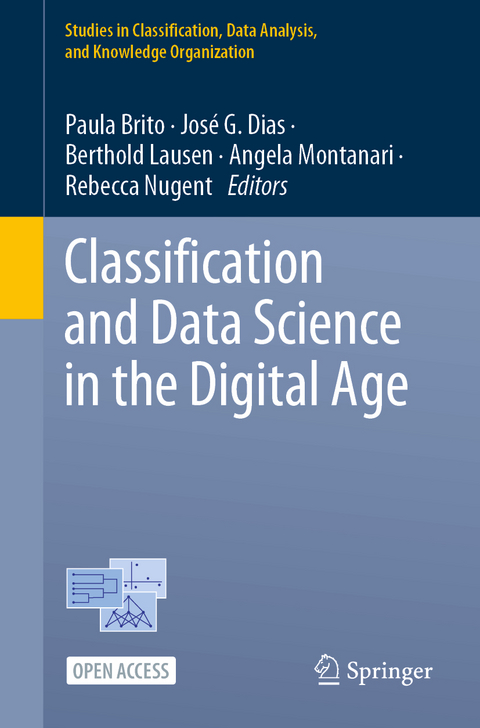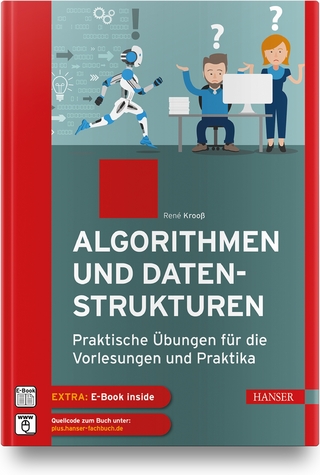
Classification and Data Science in the Digital Age
Springer International Publishing (Verlag)
978-3-031-09033-2 (ISBN)
The contributions gathered in this open access book focus on modern methods for data science and classification and present a series of real-world applications. Numerous research topics are covered, ranging from statistical inference and modeling to clustering and dimension reduction, from functional data analysis to time series analysis, and network analysis. The applications reflect new analyses in a variety of fields, including medicine, marketing, genetics, engineering, and education.
The book comprises selected and peer-reviewed papers presented at the 17th Conference of the International Federation of Classification Societies (IFCS 2022), held in Porto, Portugal, July 19-23, 2022. The IFCS federates the classification societies and the IFCS biennial conference brings together researchers and stakeholders in the areas of Data Science, Classification, and Machine Learning. It provides a forum for presenting high-quality theoretical and applied works, and promoting and fostering interdisciplinary research and international cooperation. The intended audience is researchers and practitioners who seek the latest developments and applications in the field of data science and classification.
Paula Brito is a Professor at the Faculty of Economics at the University of Porto, and a member of the Artificial Intelligence and Decision Support Research Group (LIAAD) of INESC TEC, Portugal. She holds a PhD in Applied Mathematics from the University Paris Dauphine, and a Habilitation in Applied Mathematics from the University of Porto. Her research focuses on the analysis of multidimensional complex data, known as symbolic data, for which she develops statistical approaches and multivariate analysis methodologies. Jose G. Dias is an Associate Professor with habilitation at the University Institute of Lisbon (Iscte), Portugal. He holds a PhD in Economics from the University of Groningen. At the Iscte, he is currently Deputy Director of the Department of Quantitative Methods and the coordinator of the research group in Data Analytics. He was President of the Portuguese Association for Classification and Data Analysis (CLAD). He has been an active researcher in the field of clustering. Berthold Lausen is a Full Professor of Data Science at the Department of Mathematical Sciences at the University of Essex, Colchester, UK, former president of the International Federation of Classification Societies (IFCS) from 2018 to 2019, former president of the Data Science Society (GfKl) from 2013 to 2019 and founding vice president of the European Association for Data Science (EuADS) from 2015 to 2018. His research interests are in the field of artificial intelligence, biostatistics, classification, clinical research, data science and machine learning. Angela Montanari is a Full Professor of Statistics and past Head of the Department of Statistical Sciences of the University of Bologna, Italy, the president of the International Federation of Classification Societies (IFCS) from 2020 to 2021, and former president of the Classification Group of the Italian Statistical Society (CLADAG) from 2007 to 2009. Her research interests are in the field of supervised and unsupervised classification, dimension reduction, data science and machine learning. Rebecca Nugent is the Stephen E. and Joyce Fienberg Professor of Statistics & Data Science and Head of the Statistics & Data Science Department, Pittsburgh, PA, USA. She won the ASA Waller Award for Innovation in Statistics Education and serves as co-editor of the book series Springer Texts in Statistics. She focuses on clustering and classification methodology with emphasis on large high-dimensional record linkage applications.
Preface.- R. Abdesselam: A Topological Clustering of Individuals.- C. Anton and I. Smith: Model Based Clustering of Functional Data with Mild Outliers.- F. Antonazzo and S. Ingrassia: A Trivariate Geometric Classification of Decision Boundaries for Mixtures of Regressions.- E. Arnone, E. Cunial, and L. M. Sangalli: Generalized Spatio-temporal Regression with PDE Penalization.- R. Ascari and S. Migliorati: A New Regression Model for the Analysis of Microbiome Data.- R. Aschenbruck, G. Szepannek, and A. F. X. Wilhelm: Stability of Mixed-type Cluster Partitions for Determination of the Number of Clusters.- A. Ashofteh and P. Campos: A Review on Official Survey Item Classification for Mixed-Mode Effects Adjustment.- V. Batagelj: Clustering and Blockmodeling Temporal Networks - Two Indirect Approaches.- R. Boutalbi, L. Labiod, and M. Nadif: Latent Block Regression Model.- N. Chabane, M. Achraf Bouaoune, R. Amir Sofiane Tighilt, B. Mazoure, N. Tahiri, and V. Makarenkov: Using Clustering and Machine Learning Methods to Provide Intelligent Grocery Shopping Recommendations.- T. Chadjipadelis and S. Magopoulou: COVID-19 Pandemic: a Methodological Model for the Analysis of Government's Preventing Measures and Health Data Records.- J. Champagne Gareau, É. Beaudry, and V. Makarenkov: pcTVI: Parallel MDP Solver Using a Decomposition into Independent Chains.- C. Di Nuzzo and S. Ingrassia: Three-way Spectral Clustering.- J. Dobsa and H. A. L. Kiers: Improving Classification of Documents by Semi-supervised Clustering in a Semantic Space.- J. Gama: Trends in Data Stream Mining.- L. A. García-Escudero, A. Mayo-Iscar, G. Morelli, and M. Riani: Old and New Constraints in Model Based Clustering.- V. G Genova, G. Giordano, G . Ragozini, and M. Prosperina Vitale: Clustering Student Mobility Data in 3-way Networks.- R. Giubilei: Clustering Brain Connectomes Through a Density-peak Approach.- T. Górecki, M. Suczak, and P. Piasecki: Similarity Forest for Time Series Classification.- K. Hayashi, E. Hoshino, M. Suzuki, E. Nakanishi, K. Sakai, and M. Obatake: Detection of the Biliary Atresia Using Deep Convolutional Neural Networks Based on Statistical Learning Weights via Optimal Similarity and Resampling Methods.- Ch. Hennig: Some Issues in Robust Clustering.- J. Kalina and P. Janá£ek: Robustness Aspects of Optimized Centroids.- L. Labiod and M. Nadif: Data Clustering and Representation Learning Based on Networked Data.- Lazhar Labiod and Mohamed Nadif: Towards a Bi-stochastic Matrix Approximation of k-means and Some Variants.- A. LaLonde, T. Love, D. R. Young, and T. Wu: Clustering Adolescent Female Physical Activity Levels with an Infinite Mixture Model on Random Effects.- Á. López-Oriona, J. A. Vilar, and P. D'Urso: Unsupervised Classification of Categorical Time Series Through Innovative Distances.- D. Masís, E. Segura, J. Trejos, and A. Xavier: Fuzzy Clustering by Hyperbolic Smoothing.- R. Meng, H. K. H. Lee, and K. Bouchard: Stochastic Collapsed Variational Inference for Structured Gaussian Process Regression Networks.- H. Duy Nguyen, F. Forbes, G. Fort, and O. Cappé: An Online Minorization-Maximization Algorithm.- L. Palazzo and R. Ievoli: Detecting Differences in Italian Regional Health Services During Two Covid-19 Waves.- G. Panagiotidou and T. Chadjipadelis: Political and Religion Attitudes in Greece: Behavioral Discourses.- K. Pawlasová, I. Karafiátová, and J. Dvorák: Supervised Classification via Neural Networks for Replicated Point Patterns.- G. Perrone and G. Soffritti: Parsimonious Mixtures of Seemingly Unrelated Contaminated Normal Regression Models.- N. Pronello, R. Ignaccolo, L. Ippoliti, and S. Fontanella: Penalized Model-based Functional Clustering: a Regularization Approach via Shrinkage Methods.- D. Rodrigues, L. P. Reis, and B. M. Faria: Emotion Classification Based on Single Electrode Brain Data: Applications for Assistive Technology.- R. Scimone, A. Menafoglio, L. M. Sangalli, and P. Secchi: The Death Process in Italy Before and During the Covid-19 Pandemic: a Functional Compositional Approach.- O. Silva, Á. Sousa, and H. Bacelar-Nicolau: Clustering Validation in the Context of Hierarchical Cluster Analysis: an Empirical Study.- C. Silvestre, M. G. M. S. Cardoso, and M. Figueiredo: An MML Embedded Approach for Estimating the Number of Clusters.- Á. Sousa, O. Silva, M. Graça Batista, S. Cabral, and H. Bacelar-Nicolau: Typology of Motivation Factors for Employees in the Banking Sector: An Empirical Study Using Multivariate Data Analysis Methods.- J. Michael Spoor, J. Weber, and J. Ovtcharova: A Proposal for Formalization and Definition of Anomalies in Dynamical Systems.- N. Tahiri and A. Koshkarov: New Metrics for Classifying Phylogenetic Trees Using -means and the Symmetric Difference Metric.- S. D. Tomarchio: On Parsimonious Modelling via Matrix-variate t Mixtures.- G. Zammarchi, M. Romano, and C. Conversano: Evolution of Media Coverage on Climate Change and Environmental Awareness: an Analysisof Tweets from UK and US Newspapers.
| Erscheinungsdatum | 27.10.2022 |
|---|---|
| Reihe/Serie | Studies in Classification, Data Analysis, and Knowledge Organization |
| Zusatzinfo | XIV, 416 p. 93 illus., 68 illus. in color. |
| Verlagsort | Cham |
| Sprache | englisch |
| Maße | 155 x 235 mm |
| Gewicht | 658 g |
| Themenwelt | Mathematik / Informatik ► Informatik ► Datenbanken |
| Informatik ► Theorie / Studium ► Algorithmen | |
| Informatik ► Theorie / Studium ► Künstliche Intelligenz / Robotik | |
| Mathematik / Informatik ► Mathematik ► Computerprogramme / Computeralgebra | |
| Schlagworte | classification • Clustering • Data Analysis • Data Science • dimension reduction • functional data analysis • machine learning • Mutlivariate Analysis • network analysis • open access • Statistical Inference • Statistical Learning • Time Series Analysis |
| ISBN-10 | 3-031-09033-0 / 3031090330 |
| ISBN-13 | 978-3-031-09033-2 / 9783031090332 |
| Zustand | Neuware |
| Informationen gemäß Produktsicherheitsverordnung (GPSR) | |
| Haben Sie eine Frage zum Produkt? |
aus dem Bereich


